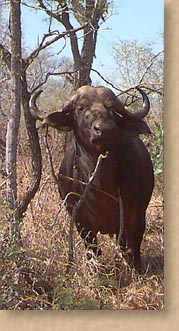MalaMala Diary Entry: 17 June 1998
The large herd of buffalo have spent the last week moving slowly down the length of the Sand River. Although conditions are dry, there is plenty of water in the river and also a good supply of dry but still nutritious grass. Buffalo are now also consuming reeds in the Sand River. One sighting several days ago revealed two large male lions - by the looks of things successors of the Manyelethi males which seem to have been pushed out of the territory which they have dominated for several years now - stalking up on the large herd of buffalo. Needless to say the 500 or so buffalo were not impressed and saw the lions off with a minimum of fuss. Elephants have continued to increase with some herds of females and youngsters reaching nearly fifty in number. This increase is almost entirely due to the lack of water and food away from the reaches of the Sand River, 37km of which run through the Mala Mala Game Reserve. The physical effects which these animals have on the environment are obvious, particularly now that the grass is dry and perhaps not as palatable. Trees and the reeds in the Sand River have felt the brunt of the elephants' feeding, the former often being uprooted and the latter eaten off at the top. On some days there are anything up to six or seven herds of elephant on the Reserve. A group of elephants spotted recently, numbered at least twenty five and obligingly walked through a large open area - something which groups of females and young are often reluctant to do, preferring the thicker bush, probably in an effort to conceal any youngsters in the herd. Although elephants really have little to fear, very young animals can occasionally fall prey to lions. It is, however, rare for youngsters to wander beyond the reach of their mothers' trunks. Large groups of sable antelope, some of which number fourteen, are now observed on an almost daily basis. One group of three sable bulls seem to have made their home in the central parts of the Reserve, drinking almost daily at the Sand River. These sable are very relaxed and have provided superb viewing. Historically these handsome antelope were plentiful, but their numbers have declined because of predators, environmental changes and numerous other factors. Now, for the first time in many years, they are becoming a regular feature on game drives in the Reserve.
Leopard viewing has continued to be superb with several recent sightings. A few days ago four different leopards were seen in the south of the Reserve, these being the Jakkalsdraai male and three females, the Selati, Toulon and another leopard, probably the Harrys female. The following day three leopards were found, one being a nervous animal which quickly disappeared. The two others were the Mlowathi female which was followed for several hours and the White Cloth female which killed a steenbok and took it up a tree. The carcass was completely eaten by the following morning and the leopard was found close to her cub, nearly 3km from the scene of this kill. She was found later that same afternoon with a duiker kill, this time up a large scotia tree. The following day these two leopards were still in the area of the kill. In addition to these leopards, the Hlabatini female was found leading her nearly two-year-old male cub to the remains of a steenbok kill. The Kapen female was observed while hunting a duiker, but this was foiled by a hyaena which arrived on the scene to harass the leopard and potentially steal the kill. Two other leopards were spotted briefly, namely an adult male and female. The latter, perhaps the Chellahanga female, followed her mate which was not very relaxed in the presence of the game drive vehicle. Such behaviour is consistent with mating.
|

 Cheetah viewing has been exceptionally good with a number of sightings over the last week. These fast cats are nowhere common and it is always a special occasion to encounter them. During one sighting a group of four - a mother and her three nearly independent sons - were seen running from a kill. Indications were that they had been driven off the kill by vultures or another competitor. Although cheetah seem quite capable of killing enough to eat, they often do not have the strength to keep these kills from competitors such as hyaenas, leopards, lions, vultures and even jackals.
Cheetah viewing has been exceptionally good with a number of sightings over the last week. These fast cats are nowhere common and it is always a special occasion to encounter them. During one sighting a group of four - a mother and her three nearly independent sons - were seen running from a kill. Indications were that they had been driven off the kill by vultures or another competitor. Although cheetah seem quite capable of killing enough to eat, they often do not have the strength to keep these kills from competitors such as hyaenas, leopards, lions, vultures and even jackals.
 Buffalo are formidable creatures when in good condition, but should their food and water supply run short, then the tables might turn and lions may have a good supply of buffalo meat. In the south of the Reserve the small herd of 60 or so buffalo are still providing good viewing.
Buffalo are formidable creatures when in good condition, but should their food and water supply run short, then the tables might turn and lions may have a good supply of buffalo meat. In the south of the Reserve the small herd of 60 or so buffalo are still providing good viewing.




